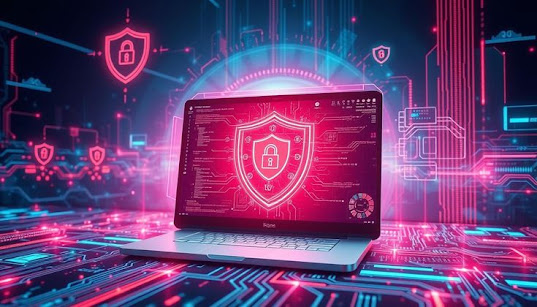How AI Is Reinventing Cyber Defense in 2025
How AI Is Reinventing Cyber Defense in 2025
In 2025, artificial intelligence (AI) is not just a buzzword in cybersecurity—it’s a foundational component of how digital defense is executed globally. With threats evolving faster than ever, AI is now the key enabler of proactive, real-time, and predictive cyber defense strategies. This article explores how AI is transforming cyber defense in 2025, from threat detection to autonomous response systems and ethical concerns.
A. The Changing Cyber Threat Landscape in 2025
Cyber threats in 2025 have become more frequent, more complex, and far more automated. Traditional firewalls and rule-based antivirus systems are no match for advanced persistent threats (APTs), polymorphic malware, and AI-driven phishing attacks.
- AI-powered malware can adapt to its environment and change its code signature.
- Deepfake attacks are now used to impersonate executives and manipulate communications.
- Zero-day vulnerabilities are exploited within hours of discovery using AI-enhanced scanning tools.
Clearly, the pace of threat evolution demands a smarter, faster, and more autonomous approach to cybersecurity.
B. How AI is Powering Cyber Defense
Artificial intelligence brings several core capabilities to modern cyber defense frameworks:
1. Real-Time Threat Detection
AI models can detect suspicious behavior in milliseconds, allowing for real-time threat identification and intervention. AI scans enormous datasets from endpoint devices, server logs, and network traffic to spot anomalies.
2. Predictive Analytics
AI uses machine learning to predict potential attacks before they occur. It does this by analyzing patterns and forecasting behaviors that historically lead to breaches.
3. Behavioral Analysis
Rather than relying on known malware signatures, AI assesses normal versus abnormal behaviors. This is vital for detecting insider threats or fileless attacks that traditional systems might miss.
4. Automated Response
AI can trigger automated defenses like quarantining devices, blocking IP addresses, or shutting down processes when it identifies a high-risk incident.
5. Threat Hunting Assistance
Cybersecurity teams are using AI-driven assistants that help them proactively hunt for vulnerabilities within vast digital infrastructures.
C. Use Cases of AI in Cybersecurity (2025 Examples)
1. Financial Sector
AI algorithms in banks now flag fraudulent transactions with high accuracy by examining spending patterns and anomalies in real-time.
2. Smart Cities
AI defends IoT networks in smart cities against DDoS attacks by detecting unusual device behavior and isolating compromised units automatically.
3. Healthcare Systems
Hospitals use AI to protect sensitive patient data by enforcing adaptive access controls and monitoring electronic medical record systems around the clock.
D. Tools & Technologies Driving AI-Powered Cyber Defense
- SIEMs with AI (e.g., IBM QRadar, Splunk) – Next-gen Security Information and Event Management tools using machine learning.
- Endpoint Detection & Response (EDR) – Platforms like CrowdStrike and SentinelOne use AI for advanced threat detection.
- Threat Intelligence Platforms – AI-enhanced systems for collecting and analyzing threat feeds.
E. Benefits of AI-Driven Cybersecurity
- Speed and Scalability: AI analyzes millions of logs per second.
- Reduced Human Error: Automated decisions reduce oversight failures.
- Cost Efficiency: AI handles tasks that once required large teams.
- Enhanced Accuracy: AI learns from previous attacks to become smarter over time.
F. Limitations and Risks of AI in Cyber Defense
Despite its promise, AI comes with challenges:
- Bias in Data: Poor data quality leads to flawed threat decisions.
- False Positives: Overactive AI models may disrupt legitimate operations.
- Adversarial AI: Hackers use AI to test and bypass defense models.
- Ethical Concerns: Surveillance systems driven by AI risk infringing on user privacy.
G. The Rise of Autonomous Security Systems
2025 has introduced a new era of cybersecurity with fully autonomous defense systems. These use AI to:
- Identify, evaluate, and respond to threats without human input
- Continuously self-update and evolve threat models
- Coordinate with other AI systems across networks for mutual protection
This has significantly reduced response times and helped enterprises defend against threats at machine speed.
H. AI and Cybersecurity Workforce in 2025
Rather than replacing cybersecurity jobs, AI is reshaping them. Cyber professionals now work alongside AI tools, focusing on:
- Strategic defense planning
- AI model supervision and fine-tuning
- Incident analysis and ethical oversight
The demand for cybersecurity professionals who understand AI has grown exponentially in 2025, making this a critical skill in the job market.
I. Future Outlook: What’s Next Beyond 2025?
- Quantum-Resistant AI: Development of algorithms that can work in tandem with post-quantum cryptographic systems
- Decentralized AI Security: Using blockchain and AI together to create tamper-proof models
- Self-Healing Networks: Systems that can autonomously recover from cyberattacks without manual intervention
J. Final Thoughts
As we progress through 2025, one thing is clear: AI is no longer optional in cybersecurity—it’s essential. From real-time threat mitigation to predicting and preventing attacks before they occur, AI has revolutionized the cyber defense landscape.
However, the journey is ongoing. With AI on both sides of the digital battlefield, the future of cyber defense will depend on ethical innovation, constant vigilance, and smart integration of AI with human expertise.
Stay informed. Stay protected. The age of AI-driven cybersecurity is here.







Comments
Post a Comment